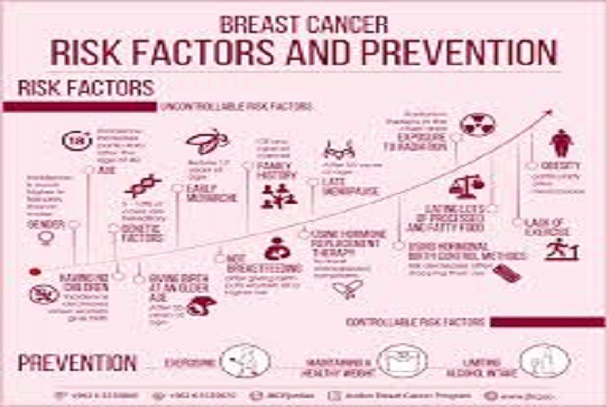Breast cancer prevention is an action taken to lower the chance of getting breast cancer. By preventing breast cancer, new cases would drastically reduce in the entire world population and also lowering the number of fatality caused by breast cancer. And in other to prevent breast cancer among women, there is a need to look at the various risk factors and protective factors that causes breast cancer.
Risk factors are the various things that increase individual chances of developing cancer; while protective factors are those things that decrease the chances of developing cancer.
Risk Factors For Breast Cancer
The following are the various risk factors for breast cancer
- Age: Old age is the main risk for breast cancer among women. Although getting older is an uncontrollable factor for every woman, yet the chances of getting breast cancer increases as a woman grows older most especially from the ages of 50 and above.
- Family History or Inherited Risk of Breast Cancer: Women with family history of a first – degree relative (mother, sister) who had breast cancer, has an increase risk of having breast cancer. This sometimes occurs when the cancer had occurred before their menopause.
- Race: It has been noted that in the USA African-American women are more likely than white women to get breast cancer before menopause.
- Genetic Mutation (Genes): Women who have inherited changes (mutation) in the BRCA1 (Breast cancer genes) and BRCA2 genes or in other genes have a higher risk of breast cancer. This mutation or changes depends on the type of gene mutation, family history of cancer and some other factors.
- Dense Breasts: Having breast tissuethat is dense on a mammogram is a factor in breast cancer risk. The level of risk depends on how dense the breast tissue is. Women with very dense breasts have a higher risk of breast cancer than women with low breast density. Increased breast density is often an inherited trait, but it may also occur in women who have not had children, have a first pregnancy late in life, take postmenopausal hormones, or drink alcohol.
- Exposure of Breast Tissue to Estrogen Made in The Body: Estrogen is a hormone made by the body. It helps the body develop and maintain female sex characteristics. Being exposed to estrogen over a long time may increase the risk of breast cancer. Estrogen levels are highest during the years a woman is menstruating.
A woman's exposure to estrogen is increased in the following ways:
- Early Menstruation: Beginning to have menstrual periods at age 11 or younger increases the number of years the breast tissue is exposed to estrogen.
- Starting Menopause at a Later Age: The more years a woman menstruates i.e. periods don’t stop until after 55 years. The longer her breast tissue is exposed to estrogen.
- Older Age at First Birth or Never Having Given Birth: Because estrogen levels are lower during pregnancy, breast tissue is exposed to more estrogen in women who become pregnant for the first time after age 35 or who never become pregnant.
- Radiation: Radiation therapyto the chest for the treatment of cancer increases the risk of breast cancer, starting 10 years after treatment. The risk of breast cancer depends on the dose of radiation and the age at which it is given. The risk is highest if radiation treatment was used during puberty, when breasts are forming.
For women who have inherited changes in the BRCA1 and BRCA2 genes, exposure to radiation, such as that from chest x-rays, may further increase the risk of breast cancer, especially in women who were x-rayed before 20 years of age.
- Obesity: Obesityincreases the risk of breast cancer, especially in postmenopausal women who have not used hormone replacement therapy.
- Alcohol: Regular drinking especially more than one drinks a day increases the risk of breast cancer.
- Benign Breast Mass: There is an increase in odd for women with certain benign non cancerous breast mass to have breast cancer.
Protective Factors for Breast Cancer
- Weight Control:Losing weight or controlling one’s weight can help a woman live a healthy life, thus reducing the risk of having breast cancer.
- Exercising: Regular exercise can help reduce the risk of having breast cancer
- Limit or Skip Alcohol:It is highly recommended that women should have no more than 1 alcoholic drink a day so as to reduce the risk of having breast cancer.
- Screening:This is the most important way in preventing breast cancer. It is recommended as women to get their breast screened regularly especially between the ages of 40 – 80.
- Less Exposure of Breast Tissue To Estrogen Made By The Body: Decreasing the length of time a woman's breast tissue is exposed to estrogen may help prevent breast cancer. Exposure to estrogen is reduced in the following ways:
- Early Pregnancy: Estrogen levels are lower during pregnancy. Women who have a full-term pregnancy before age 20 have a lower risk of breast cancer than women who have not had children or who give birth to their first child after age 35.
- Breast - feeding: Estrogen levels may remain lower while a woman is breast-feeding. Women who breastfeeds, have a lower risk of breast cancer than women who have had children but did not breastfeed.
 Wash your hands regularly and wear a face mask.
Learn more
Wash your hands regularly and wear a face mask.
Learn more
